非谓语动词作状语
- 格式:doc
- 大小:75.00 KB
- 文档页数:11
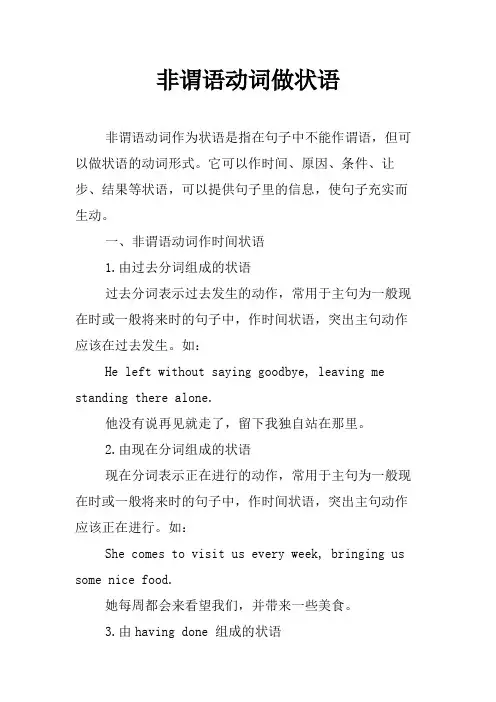
非谓语动词做状语非谓语动词作为状语是指在句子中不能作谓语,但可以做状语的动词形式。
它可以作时间、原因、条件、让步、结果等状语,可以提供句子里的信息,使句子充实而生动。
一、非谓语动词作时间状语1.由过去分词组成的状语过去分词表示过去发生的动作,常用于主句为一般现在时或一般将来时的句子中,作时间状语,突出主句动作应该在过去发生。
如:He left without saying goodbye, leaving me standing there alone.他没有说再见就走了,留下我独自站在那里。
2.由现在分词组成的状语现在分词表示正在进行的动作,常用于主句为一般现在时或一般将来时的句子中,作时间状语,突出主句动作应该正在进行。
如:She comes to visit us every week, bringing us some nice food.她每周都会来看望我们,并带来一些美食。
3.由having done 组成的状语having done 表示过去已经完成的动作,常用于主句为一般现在时或一般将来时的句子中,作时间状语,突出主句动作应该在过去完成的动作之后发生。
如:Having finished the exam, he went home and had a good rest.考试结束之后,他回家好好休息了。
二、非谓语动词作原因状语由because of,due to,owing to,thanks to等引导,接名词或动词不定式,作原因状语,表示主句动作的原因。
如:Because of the heavy rain, we had to cancel our picnic.由于下雨,我们不得不取消野餐了。
三、非谓语动词作条件状语由if,unless,in case,on condition that,provided (that),supposing (that)等引导,接动词不定式,作条件状语,表示“假设”的意思,表示主句动作的前提,即要想主句动作成立,必须满足什么条件。

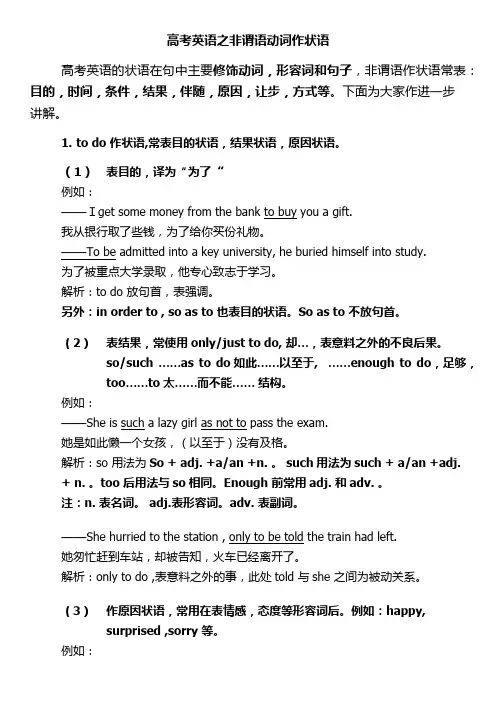
高考英语之非谓语动词作状语高考英语的状语在句中主要修饰动词,形容词和句子,非谓语作状语常表:目的,时间,条件,结果,伴随,原因,让步,方式等。
下面为大家作进一步讲解。
1.to do 作状语,常表目的状语,结果状语,原因状语。
(1)表目的,译为“为了“例如:——Iget some money from the bank to buy you a gift.我从银行取了些钱,为了给你买份礼物。
——To be admitted into a key university, he buried himself into study.为了被重点大学录取,他专心致志于学习。
解析:to do 放句首,表强调。
另外:in order to , so as to 也表目的状语。
So as to 不放句首。
(2)表结果,常使用only/just to do, 却…,表意料之外的不良后果。
so/such ……as to do如此……以至于, ……enough to do,足够,too……to太……而不能……结构。
例如:——She is such a lazy girl as not to pass the exam.她是如此懒一个女孩,(以至于)没有及格。
解析:so 用法为So + adj. +a/an +n. 。
such用法为such + a/an +adj.+ n. 。
too 后用法与so相同。
Enough 前常用adj. 和adv. 。
注:n. 表名词。
adj.表形容词。
adv. 表副词。
——She hurried to the station , only to be told the train had left.她匆忙赶到车站,却被告知,火车已经离开了。
解析:only to do ,表意料之外的事,此处told 与she 之间为被动关系。
(3)作原因状语,常用在表情感,态度等形容词后。
例如:happy,surprised ,sorry 等。

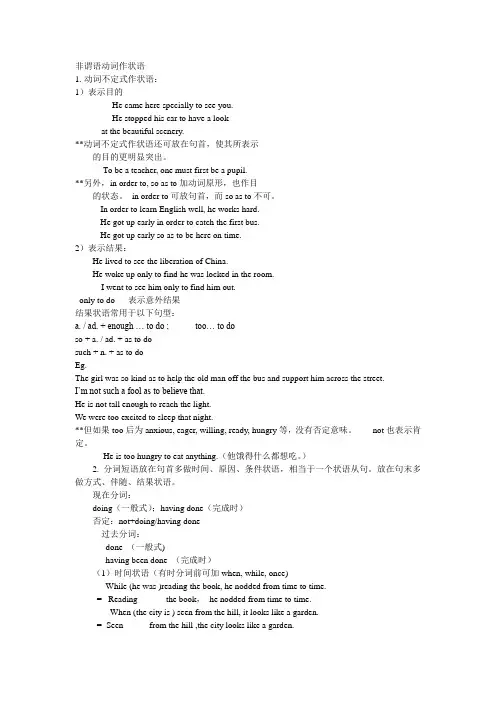
非谓语动词作状语1.动词不定式作状语:1)表示目的--- He came here specially to see you.--- He stopped his car to have a lookat the beautiful scenery.**动词不定式作状语还可放在句首,使其所表示的目的更明显突出。
--- To be a teacher, one must first be a pupil.**另外,in order to, so as to加动词原形,也作目的状态。
in order to可放句首,而so as to不可。
-- In order to learn English well, he works hard.-- He got up early in order to catch the first bus.-- He got up early so as to be here on time.2)表示结果:He lived to see the liberation of China.He woke up only to find he was locked in the room.I went to see him only to find him out.only to do 表示意外结果结果状语常用于以下句型:a. / ad. + enough … to do ; too… to doso + a. / ad. + as to dosuch + n. + as to doEg.The girl was so kind as to help the old man off the bus and support him across the street.I’m not such a fool as to believe that.He is not tall enough to reach the light.We were too excited to sleep that night.**但如果too后为anxious, eager, willing, ready, hungry等,没有否定意味。
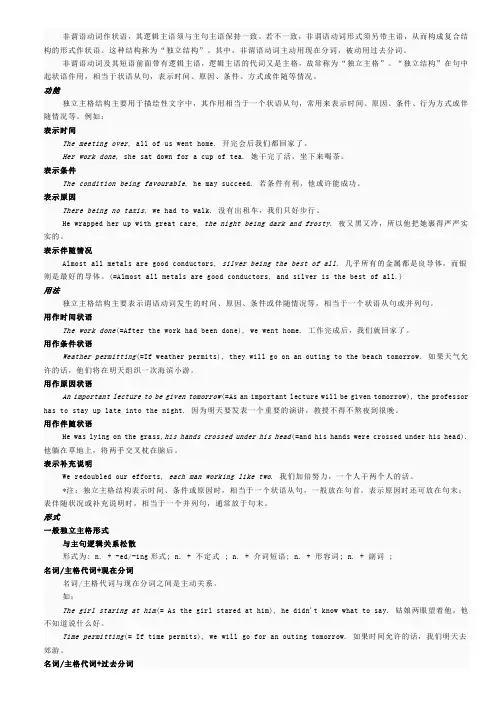
非谓语动词作状语,其逻辑主语须与主句主语保持一致。
若不一致,非谓语动词形式须另带主语,从而构成复合结构的形式作状语。
这种结构称为“独立结构”。
其中,非谓语动词主动用现在分词,被动用过去分词。
非谓语动词及其短语前面带有逻辑主语,逻辑主语的代词又是主格,故常称为“独立主格”。
“独立结构”在句中起状语作用,相当于状语从句,表示时间、原因、条件、方式或伴随等情况。
功能独立主格结构主要用于描绘性文字中,其作用相当于一个状语从句,常用来表示时间、原因、条件、行为方式或伴随情况等。
例如:表示时间The meeting over, all of us went home. 开完会后我们都回家了。
Her work done, she sat down for a cup of tea. 她干完了活,坐下来喝茶。
表示条件The condition being favourable, he may succeed. 若条件有利,他或许能成功。
表示原因There being no taxis, we had to walk. 没有出租车,我们只好步行。
He wrapped her up with great care, the night being dark and frosty. 夜又黑又冷,所以他把她裹得严严实实的。
表示伴随情况Almost all metals are good conductors, silver being the best of all. 几乎所有的金属都是良导体,而银则是最好的导体。
(=Almost all metals are good conductors, and silver is the best of all.)用法独立主格结构主要表示谓语动词发生的时间、原因、条件或伴随情况等,相当于一个状语从句或并列句。
用作时间状语The work done(=After the work had been done), we went home. 工作完成后,我们就回家了。

高中英语语法专题:非谓语动词作状语非谓语动词作状语 解题步骤1、找到非谓语动词的逻辑主语。
2、看非谓语动词和逻辑主语之间的关系。
如果是主动关系,用现在分词;如果是被动关系,用过去分词。
3、如果非谓语动词是分词,需看分词和谓语动词的先后关系。
如果分词的动作发生在谓语动词之前,要使用分词的完成式。
注:如果分词的逻辑主语不是句子的主语,可以使用状语从句或者独立主格结构。
非谓语动词作状语 考点例题考点1、不定式作目的状语【2018∙全国1】You don’t have to run fast or for long__62 _ (see) the benefit.答案:to see。
句意:要见效果,你不必跑的太快或太久。
不定式作目的状语。
考点2、不定式作结果状语【2015∙全国2】When a new day breaks, the walls have given up their heat and are now cold enough __46 __ (cool) the house during the hotday .答案:to cool。
adj. + to do作结果状语考点3、不定式作原因状语【2012∙全国2】⒖ The old man sat in front of the television every evening, happy ___ anything that happened to be on.A.to watchB.watchingC.watchedD.to have watched答案:A。
adj. + to do不定式作原因状语中,adj.通常表示情绪,不定式表示引起情绪变化的原因。
考点4、现在分词作结果状语【2017天津】14. The hospital has recently obtained new medical equipment, _____ more patients to be treated.A. being allowedB. allowingC. having allowedD. allowed答案:B。
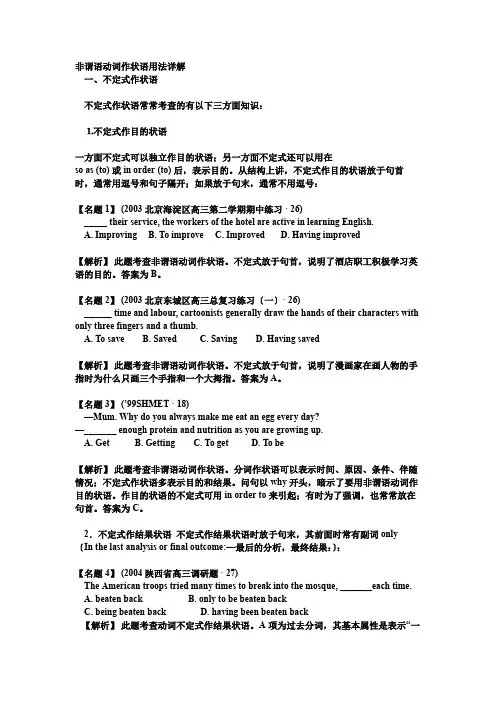
非谓语动词作状语用法详解一、不定式作状语不定式作状语常常考查的有以下三方面知识:⒈不定式作目的状语一方面不定式可以独立作目的状语;另一方面不定式还可以用在so as(to)或in order(to)后,表示目的。
从结构上讲,不定式作目的状语放于句首时,通常用逗号和句子隔开;如果放于句末,通常不用逗号:【名题1】(2003北京海淀区高三第二学期期中练习·26)_____their service,the workers of the hotel are active in learning English.A.ImprovingB.To improveC.ImprovedD.Having improved【解析】此题考查非谓语动词作状语。
不定式放于句首,说明了酒店职工积极学习英语的目的。
答案为B。
【名题2】(2003北京东城区高三总复习练习〔一〕·26)______time and labour,cartoonists generally draw the hands of their characters with only three fingers and a thumb.A.To saveB.SavedC.SavingD.Having saved【解析】此题考查非谓语动词作状语。
不定式放于句首,说明了漫画家在画人物的手指时为什么只画三个手指和一个大拇指。
答案为A。
【名题3】(’99SHMET·18)—Mum.Why do you always make me eat an egg every day?—_______enough protein and nutrition as you are growing up.A.GetB.GettingC.To getD.To be【解析】此题考查非谓语动词作状语。
分词作状语可以表示时间、原因、条件、伴随情况;不定式作状语多表示目的和结果。
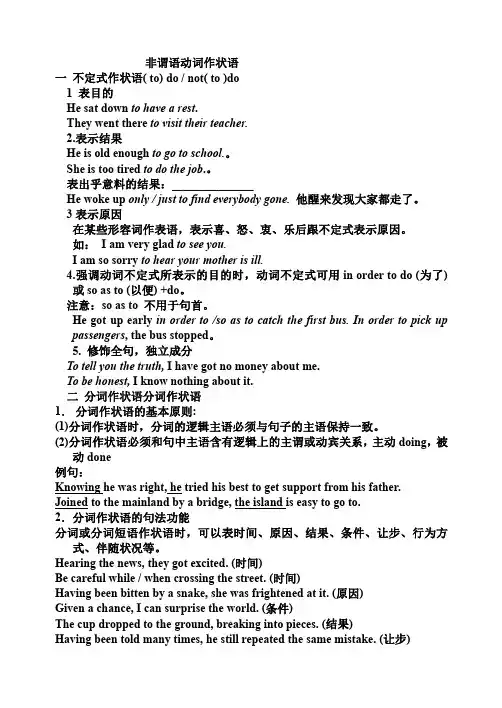
非谓语动词作状语一不定式作状语(to)do/not(to)do1表目的He sat down to have a rest.They went there to visit their teacher.2.表示结果He is old enough to go to school.。
She is too tired to do the job.。
表出乎意料的结果:______________He woke up only/just to find everybody gone.他醒来发现大家都走了。
3表示原因在某些形容词作表语,表示喜、怒、衷、乐后跟不定式表示原因。
如:I am very glad to see you.I am so sorry to hear your mother is ill.4.强调动词不定式所表示的目的时,动词不定式可用in order to do(为了)或so as to(以便)+do。
注意:so as to不用于句首。
He got up early in order to/so as to catch the first bus.In order to pick up passengers,the bus stopped。
5.修饰全句,独立成分To tell you the truth,I have got no money about me.To be honest,I know nothing about it.二分词作状语分词作状语1.分词作状语的基本原则:(1)分词作状语时,分词的逻辑主语必须与句子的主语保持一致。
(2)分词作状语必须和句中主语含有逻辑上的主谓或动宾关系,主动doing,被动done例句:分词或分词短语作状语时,可以表时间、原因、结果、条件、让步、行为方式、伴随状况等。
Hearing the news,they got excited.(时间)Be careful while/when crossing the street.(时间)Having been bitten by a snake,she was frightened at it.(原因)Given a chance,I can surprise the world.(条件)The cup dropped to the ground,breaking into pieces.(结果)Having been told many times,he still repeated the same mistake.(让步)The teacher came into the lab,followed by some students.(伴随状况)例句:(1)Having worked there for30years,Haydn moved to London先后(2)Having been knocked down by the car for so long,the old man was sent tothe hospital.(3)Not having finished his work,he had to work extra hours at night.因为没有完成工作,他不得不晚上额外加班。
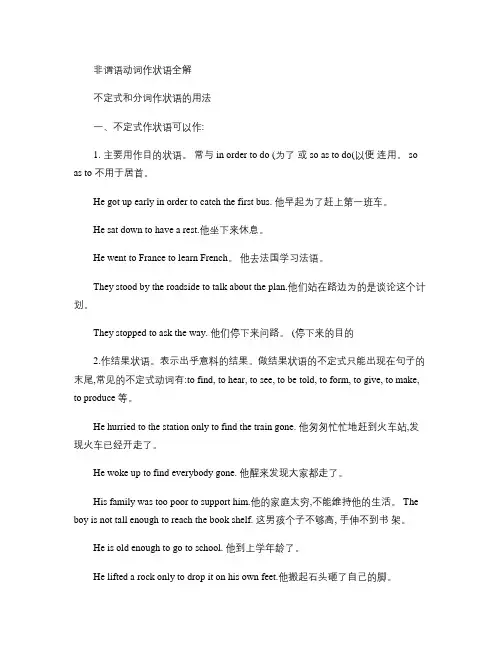
非谓语动词作状语全解不定式和分词作状语的用法一、不定式作状语可以作:1. 主要用作目的状语。
常与 in order to do (为了或 so as to do(以便连用。
so as to 不用于居首。
He got up early in order to catch the first bus. 他早起为了赶上第一班车。
He sat down to have a rest.他坐下来休息。
He went to France to learn French。
他去法国学习法语。
They stood by the roadside to talk about the plan.他们站在路边为的是谈论这个计划。
They stopped to ask the way. 他们停下来问路。
(停下来的目的2.作结果状语。
表示出乎意料的结果。
做结果状语的不定式只能出现在句子的末尾,常见的不定式动词有:to find, to hear, to see, to be told, to form, to give, to make, to produce 等。
He hurried to the station only to find the train gone. 他匆匆忙忙地赶到火车站,发现火车已经开走了。
He woke up to find everybody gone. 他醒来发现大家都走了。
His family was too poor to support him.他的家庭太穷,不能维持他的生活。
The boy is not tall enough to reach the book shelf. 这男孩个子不够高, 手伸不到书架。
He is old enough to go to school. 他到上学年龄了。
He lifted a rock only to drop it on his own feet.他搬起石头砸了自己的脚。

非谓语动词做状语在写作中的应用非谓语动词包括动词不定式、动名词和分词(现在分词和过去分词),它们在写作中做状语时可以丰富句子表达,增强文采。
一.动词不定式做状语1.目的状语可以用来表示目的,常放于句首或句末。
例如,“To improve my English, I read English novels every day.”(为了提高我的英语水平,我每天读英语小说),这里的“To improve my English”表明了读书这个行为的目的。
在句尾时,如“I get up early to catch the first bus.”(我早起是为了赶上头班车)。
2.结果状语常与“only”连用,表示出乎意料的结果。
例如,“He rushed to the station only to find the train had left.”(他匆忙赶到车站,结果却发现火车已经开走了)。
二.现在分词做状语1.时间状语当分词的动作与主句的动作同时发生时,可以用现在分词作时间状语。
例如,“Walking in the park, I met an old friend.”(在公园里散步的时候,我遇到了一位老朋友),“Walking in the park”这个动作和“met an old friend”同时发生。
2.原因状语表原因,相当于一个原因状语从句。
如“Being ill, he didn't go to school.”(因为生病了,他没去上学),这里“Being ill”是他没去上学的原因。
3.伴随状语表示伴随状况,与主句的动作同时进行。
比如,“The girl sat there, reading a book.”(女孩坐在那儿,读着一本书),“reading a book”伴随“sat”这个动作。
过去分词做状语1.时间状语和现在分词类似,当过去分词表示的动作先于主句动作时,可作时间状语。
非谓语动词作状语技巧非谓语动词作状语是英语语法中的一种常见结构,通过这种结构可以更加准确地表达句子中的时间、原因、方式、目的等状语关系。
在英语写作中,灵活运用非谓语动词作状语的技巧可以使句子更加简洁、流畅和准确。
本文将介绍几种非谓语动词作状语的常见技巧,包括现在分词、过去分词、不定式和动名词。
1. 现在分词作状语现在分词作状语表示的是与主句谓语动词同时或先于主句谓语动词发生的动作或状态。
常见的现在分词作状语的结构有:现在分词+宾语、现在分词+介词短语、现在分词+时间状语等。
例如:- Walking along the street, I noticed a stray cat.(当我沿着街道走的时候,我注意到了一只流浪猫。
)- Having finished his homework, he went out to play basketball.(他完成作业后,出去打篮球。
)- With the sun shining brightly, we decided to go for a picnic.(太阳明亮地照着,我们决定去野餐。
)2. 过去分词作状语过去分词作状语表示的是与主句谓语动词同时或先于主句谓语动词发生的动作或状态,强调被动或完成的意义。
常见的过去分词作状语的结构有:过去分词+宾语、过去分词+介词短语、过去分词+时间状语等。
例如:- Exhausted from the long journey, she went straight to bed.(因为长途旅行而疲惫不堪,她直接上床睡觉。
)- Having been invited to the party, I couldn't refuse.(因为被邀请参加派对,我不能拒绝。
)- Surprised by the sudden news, they didn't know how to react.(因为突然的消息,他们不知道如何反应。
Time permitting,I’ll go to see my teacher. (permit)时间允许的话, 我将去看我的老师。
The teacher mixed three different liquids, finding that the mixture was red .(find)老师混合三种不同的液体,结果发现混合物呈现出红色。
Having been criticized by his classmates, he didn’t go to the Internet bar to play computer games any more.(criticize)挨了同学的批评后,他不再去网吧玩游戏。
Being too young, Li Ming can’t join the party.(young)由于年龄太小,李明不能入党。
Be careful when crossing the street.(cross)过街时小心。
Not having received an answer, he decided to write another letter.(receive)没收到答复,他决定再写封信。
Looking at my classmates’ faces, I read the same excitement in their eyes.(look)当看同学们脸时,我在他们眼中看到了同样的兴奋。
The retired man donated most of his savings to the school damaged by an earthquake in Yushu enabling the students to return to their classrooms(enable)退休老人把他的大部分积蓄捐给了玉树地震毁掉的学校,让学生们能够重返教室。
It rained heavily in the south, causing serious flooding in several provinces.(cause)南方大雨,造成几省严重洪灾。
非谓语动词作状语的易错点1、位置问题。
(1) 非谓语动词作状语放在句首,一般会有逗号与主句隔开。
T o complete the project in time, the staff were working at weekends. (2009 天津,4) Encouraged by the advances in the technology, many farmers have set up wide farms on their land. (2009 天津,4)Tired but excited, tourists rushed to the adventurous activities.Tired but excited tourists rushed to the adventurous activities. (定语)(2) 非谓语动词作状语放在句末,有无标点,含义常不同。
They worked hard in school to enter a key college. (表目的)They worked hard in school, entering a key college. (表结果)They worked hard in schoo l, just / only to find it in vain. (表意想不到的结果)He was busy writing a story, only stopping once in a while to smoke a cigarette. (表伴随)Lucy’s new job paid twice as much as she had made working in the r e staurant. (表时间)2、逻辑主语应准确。
非谓语动词作状语,非谓语动词的逻辑主语就是主句的主语,非谓语动词的动作与主句的主语应有正确的逻辑关系:主谓或动宾关系,否则表达出来的句子就是错句。
非谓语动词作状语在成份上,非谓语动词都可以作状语.在时态上,ing表"进行",ed表"完成",在语态上,ing 表"主动",ed表"被动".在概念上,ing表"抽象,习惯",不定式表"具体,偶然,将来".非谓语动词(非谓)做状语主要就是要把握非谓与主句主语的"主被动关系"和主句"动作发生的先后顺序".一般说来,在时间上,非谓的一般式与谓语动作同时发生,完成式先于谓语动作之前发生,进行式在谓语动词动作发生时正在进行.(注意否定词not要加在非谓前)eg: They had a good time at the party, singing and dancing. (一般式)(在派对上玩和唱歌跳舞是同时的,且与主语they呈主动关系)Having waited in the queue for half an hour, the old man suddenly realized he had left the cheque in the car. (完成式)(排队等了半个小时后,那个老人忽然意识到自己把支票忘在车上了."排队"这个动作发生在"意识到忘带支票之前")They seemed to be eating something that they had cooked on the fire. (进行式,常常是不定式的进行式.)二.详解1. 不定式作状语表示目的,结果,原因等.其逻辑主语必须是句子的主语,如果不是则要加上其自身的主语,即独立主格结构.(ing和ed也一样).不定式要把握以下几点:*表目的用不定式 eg: To finish the work before time, we'd better ask Tom for help. 为了提前完成工作,我们最好找Tom帮忙.* 动作还没发生,将来的,用不定式.*表出乎意料的结果要用不定式.eg: 我们终于到了那里,却发现没有人在那里.In the end, we arrived there only to find nobody there. (对)In the end, we arrived there only finding nodody there. (错)现在分词在句中作结果时表示意料之中的事,而不定式表意料不到的事情.2.分词作状语形式意义ing与逻辑主语呈主动关系,与主句动作同时发生,或基本上同时发生.having done与逻辑主语为主动关系,动作发生在主句动作之前.done与逻辑主语为被动关系,动作完成.being + done 与逻辑主语为被动关系,与为主动作同时发生,一般作原因状语,放名首.having been done与逻辑主语为被动关系,先于主句动作发生.eg: Given more time, he would finish the plan. 多给些时间他就能完成计划.Getting off the bus, she saw her mother. 一下车她就看见了她妈妈.Having passed the exam, she told everybody the good news.通过了考试后,她把这个好消息告诉了每个人.Having been told many times, she still couldn't understand me.跟她说了很多次她还是不能理解我的意思.Being asked to give a speech, she didn't know how to refuse.被邀做演讲时,她不知道怎么拒绝.注:以上各点也适用于非谓语动词做其它成份的情况.混合练习(按步骤:*找主语 *找主句谓语 *判断非谓与主语的主被动关系 *比较非谓和主句动作先后,对照上表来做就不容易出错了)1 _____ their service, the workers of the hotel are active in learning English.A. ImprovingB. To improveC. ImprovedD. Having improved【解析】本题考查非谓语动词作状语。
非谓语动词作状语例句
1. 她坐在河边垂钓,静静地等待鱼儿上钩。
2. 他推开门,一边笑着一边走进了屋子。
3. 放学后,他和朋友们一起打篮球,汗流浃背地奔跑着。
4. 她一边吃着早餐,一边浏览报纸上的新闻。
5. 他经过公园,看到一群小孩在草地上疯跑。
6. 在参观博物馆时,她拿出相机记录下了每个展品。
7. 他站在舞台上,挥着手向观众致意。
8. 爸爸开车带我们去郊外游玩,一路上欢声笑语地唱歌。
9. 她躺在沙滩上晒太阳,闭上眼睛享受着悠闲的时光。
10. 妈妈忙着做饭,同时还指示我们收拾房间。
非谓语动词作状语不定式、现在分词、过去分词作状语的比较1、不定式作目的、原因、结果状语1)作目的状语:有三种形式,可互换:to do, in order to do, so as to do (不用于句首)e.g. We eat to live, but we don’t live to eat.We started early (in order / so as) to avoid being late. 我们一早动身,免得迟到。
(In order )not to waste electricity, we turned the light off.Check your composition carefully so as to avoid mistakes. (so as to只能置于主句之后) 【Exercises】1.—Did the book give the information you needed?—Yes. But ____ it, I had to read the entire book. 【2008 北京】A. to findB. findC. to be findingD. finding2.______this cake, you'll need 2 eggs, 175 g sugar and 175 g flour. 【2006广东卷】A. Having madeB. MakeC. To makeD. Making2)作原因状语:不定式常放在表示情绪反应的形容词后。
如:happy, sorry, glad, sad, surprised, disappointed…不定式不放在句首。
e.g. :I am sorry to hear that your father is ill.We are greatly delighted to have a native as our guide.有一个本地人做向导,我们真是太高兴了。
【Exercises】1. I feel greatly honored ____ into their society. 【2008北京卷】A. to welcomeB. welcomingC. to be welcomedD. welcomed3) 作结果状语:不定式作结果状语通常表意外的结果。
e.g. I opened the door to find the room empty. 我打开门,结果发现房间是空的。
【attention】:①. 动词不定式前可以加上only, 更加强调‘意外,想不到’。
还可加never, 表示‘没有再…’e.g. He hurried to the station only to find that the train had left.他匆忙到了车站结果却发现火车已经离开了。
They parted, never to see each other again. 他们分手了,从此没有再见面。
②. 动词不定式作结果状语的其他几种方式:so + adj. / adv. + as to, such + n. + as to,too…to , enough to等。
e.g. Would you be so kind as to lend me your bicycle / tell me the time?They lifted a rock only to drop it on their own feet.________________________________He worked hard only to fail. _______________________________________他匆匆忙忙的跑到车站,结果却发现火车已经走了。
_______________________________________________________________2. He hurried to the booking office only _________that all the tickets had been sold out. 06陕西卷)A. to tell B. to be told C. telling D. told注意:不定式做结果状语的固定搭配①so …as to …Would you be so kind as to lend me your bicycle / tell me the time?I’m not such a fool as to believe that.His eyesight is too poor to read such small letters.The boy is old enough to go to school.2、分词(现在分词、过去分词)可作时间、条件、让步、方式、原因、结果状语,就不作目的状语。
注:表示时间、条件或让步的分词,有时可带上连词(if, unless, when, while, once(一旦)though, although)1)现在分词作状语:e.g. ①. (While) Working in the factory, he was an advanced worker. 【作时间状语】Hearing the news, they all danced for joy. 听到这个消息,他们都高兴得跳起舞来。
②.Being a League member, he is always helping others. 作为一个团员,他总是乐于助人。
Being students, we must study hard. 【作原因状语】③.He stayed at home, cleaning and washing. 【作伴随状语】She wrote him a friendly letter, thanking him for his help.他写了一封友好的信给他,感谢他的帮助。
④.Playing all day, you will waste your valuable time. 【作条件状语】⑤.He dropped the glass, breaking it into pieces 【作结果状语】His parents died last year, leaving him an orphan.他的父母亲去年死了,使他成为了一个孤儿。
⑥.Though raining heavily, it cleared up very soon. 【作让步状语】Feeling tired, he went on running. 尽管感觉累,他还是继续跑。
2)过去分词作状语:e.g. ①. Seen from the top of the hill, the city looked like a big garden. 【作时间状语】Accepted by the Party, he decided to devote his life to the cause of the Party.从被党接受的那一刻起,他决定要把他的一生致力于党的事业。
②.Deeply moved by the story, the excited people stopped quarrelling with each other.Encouraged by the speech, the young people made up their minds to take up the struggle.受到演讲的激励,年轻人下定决心开始进行斗争。
【作原因状语】③.The old man went into the room, supported by his wife. 【作伴随状语】④.Given another chance, he will do better. 【作条件状语】⑤.Wounded, the brave soldier continued to fight.虽然受伤了,但这名勇敢的战士还继续作战。
【作让步状语】【Summary】:分词短语作状语时,其逻辑主语必须与句子的主语一致。
如果分词与句子的主语是主动关系,用doing表示与谓语动词同时发生或进行的动作,用having done表示在谓语动词之前发生的动作。
如果分词与句子的主语是被动关系,则用done强调在谓语动词之前发生的动作,也可用having been done.【attention】:①. 不定式与现在分词引导结果状语的区别:e.g. 1. He got home to learn that his father was ill.2. They lifted a rock only to drop it on their own feet. 他们搬起石头却砸了自己的脚。
3. I ran to the school, only to be informed that I wasn't admitted by Beijing University.我跑到学校,却被告知我没有被北大所录取。
4. It rained heavily, causing severe flooding.雨下得很大,导致了非常严重的涝灾。
5. He cut off the electricity quickly, preventing an accident.他快速地切断了电,避免了一场事故。
【summary】:不定式做结果状语通常表示的是一个未曾料到的不愉快的结果,前可加only作为结果状语的现在分词短语所表示的都是谓语动词的直接结果,是意料中的结果。
分词短语前有时可加上副词thus或thereby(因而、因此)。
(only) to do →出乎意料干某事(thus / thereby) doing →顺理成章干某事②.英语中有些形容词化的过去分词(短语),常省略be动词,在句中作状语。
常见的有:be lost in, be faced with, be located in, be dressed in, be tired of等等。
e.g. Faced with so many problems, he felt depressed.Located in the centre of Longhui, NO.1 Middle School of LH is the best school in the town.③.有时“with(without) + 名词(或代词宾语) + 分词”的结构,表示伴随状况。